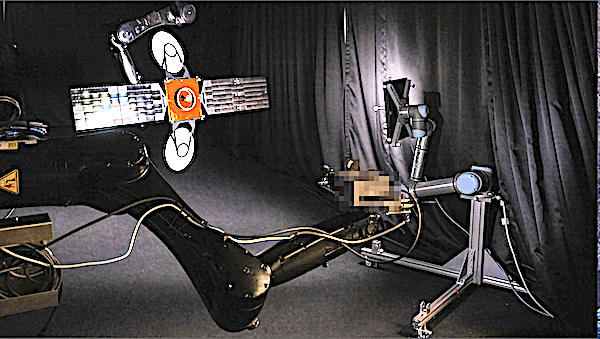
European Space Agency’s Guidance Navigation and Control (GNC) Rendezvous, Approach and Landing Simulator, GRALS — part of its Guidance, Navigation and Control Test Facilities at the ESTEC technical centre in the Netherlands — was used by Lithuanian company Blackswan Space for the testing of their autonomous satellite navigation technology.
This Vision Based Navigation (VBN) system enables satellites to identify and approach or avoid other objects in space with the help of AI — in a way akin to self-driving cars.
“As the satellite numbers are growing rapidly, such capability is key in enabling us to not only better manage the increasing space traffic, but also service satellites that need repairs or are simply out of fuel,” notes Marius Klimavičius, founder and CEO of Blackswan Space. “We see a growing demand for our product as the new market of in-orbit servicing emerges.”
ESA’s GNC System Engineer Irene Huertas García explains: “At the beginning stages of vision-based technology developments, space scenarios are simulated using software. As maturity of the developed solution increases, we need a more representative real-world ‘hardware-in-the-loop’ testing in visual conditions resembling space. GRALS enables such test conditions, including darkened surroundings and a Sun-like light source as required.”
Joris Belhadj of the GNC Test Facilities adds: “The lab’s model satellite – called BlackGEO– has been manufactured to contain typical elements of a geostationary satellite’s topography, with characteristic satellite surface materials including multi-layer insulation and solar cells to enhance its optical representativity. The satellite was also produced by Blackswan under ESA contract, and any customers of our laboratory can now make use of it.”
By leveraging the capabilities of ESTEC’s GRALS, Blackswan has successfully demonstrated the potential of Vision Based Navigation to enhance space traffic management and enable in-orbit servicing. The company’s access to the GNC facility was supported through ESA’s General Support Technology Programme (GSTP).
The collaboration between ESA and Blackswan Space is strongly backed by the Lithuanian Space delegation. Following the successful test campaign, the delegation has committed to provide ongoing funding to advance Blackswan’s VBN system to TRL 6 within the next 12 months, with an in-orbit demonstration mission planned for 2027.
ESA is currently developing its own in-orbit servicing mission, RISE, targeting telecommunications satellites in geostationary orbit.
